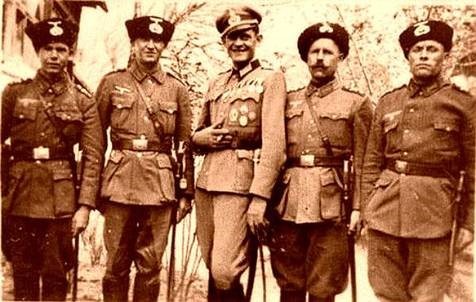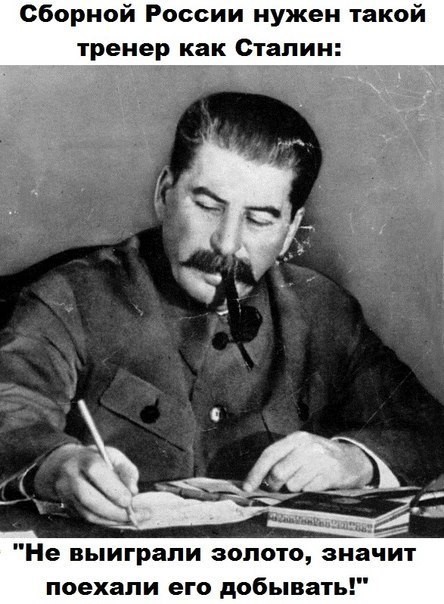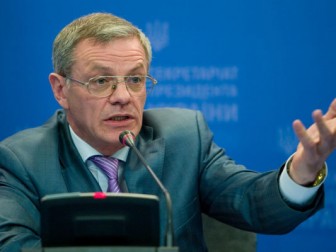Who they are, where they came from, what they represent
By Myroslaw Shkandrij
Although Vladimir Putin has so far stopped short of a full-scale invasion of Eastern Ukraine, he has used mercenaries trained by the Russian military to organize anti-government acts in the region. Who are these soldiers and where did they come from? A number of websites and bloggers have provided profiles of some fighters. It is evident from these profiles that the core group was trained by Russian military instructors, mostly in Krasnodarskii Krai in the Kuban. Some of the fighters have dubious pasts, all hold extremist right-wing views.
One blogger writes that the uprising in the Donbas is driven by socio-economic grievances rooted in poverty, corruption and local misrule. He argues that far-right forces from Russia have taken control of the uprising and are trying to channel the population’s anger and frustration by getting them to support a Russian nationalist platform. So far the expected widespread support has not materialized. Despite the ‘referendum’ of May 11, polls consistently show that the vast majority of people in the Donbas region oppose both separatism and Russian rule. The blogger argues that when the extremist views espoused by many of the mercenaries become better known there will be even less support for the interventionists (Tolkovatel, http://ttolk.ru/?p=20508). In Sloviansk the recent attacks upon and looting of Romani (Gypsies), distribution of antisemitic leaflets, and hunt for Ukrainian speakers is in line with the racist views of these mercenary forces (See http://ukrainianpolicy.com/pro-russian-separatists-loot-assault-romani-in-sloviansk/)
Over the last few years Russian authorities have nurtured far-right paramilitary groups by supporting reconstructionist groups (who rebuild tsarist military organizations and reenact battles), knife-fighting clubs, biker gangs (the Night Wolves are Putin’s favourite gang), and detachments of Cossacks. Vladislav Surkov is considered the first to come up with the idea of placing extreme right-wing groups ‘at the service of the Motherland.’ In the century’s first decade, as deputy-head of the President Putin’s administration with responsibility for internal politics, he decided to disrupt political opposition groups of all kinds (from followers of Eduard Limonov’s National Bolshevik party to antifascists) by using violent gangs recruited from football fans. Then the neo-Nazi organization BORN (Battle Organization of Russian Nationalists) appeared, and implemented more radical ways of ‘solving’ the ‘opposition problem’ by killing human rights activists and journalists (See Lynch, http://balkanist.net/right-world/2).
Here are some of profiles of individuals fighting in the Donbas.
1. Strelkov-Girkin
The leader of the ‘Donbas self-defence’ force is Igor ‘Strelkov.’ His real surname is Girkin. He was born in 1970, and comes from Moscow. An avid reconstructor of historical events, he loves to dress up in the uniforms of the White armies who fought in the South, and to reenact the campaigns of the Volunteer Army of South Russia from the period 1918-1920. He took part in reenactments of the ‘War of 1916’ in 2009 and the ‘Civil War’ in 2010. He has also participated in reenactments of Russia’s imperial wars.
From June 1993 until July 1994 he served as a rifleman in a company of guards. Then in 1995 he was on contract service, mainly as deputy commander of a platoon. His last service was ‘directing the struggle against international terrorism’ while working for the Russian FSB (Security Service). It is rumoured that he was fired from the FSB in the autumn of 2013.
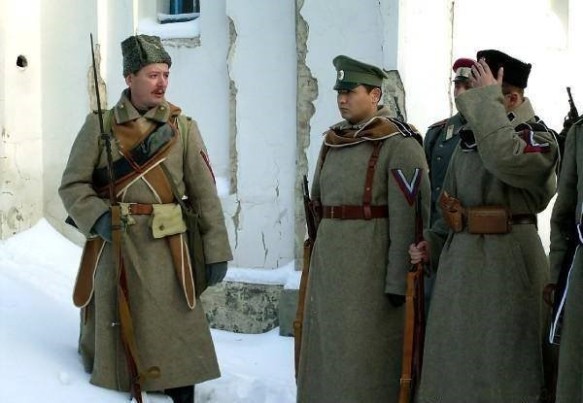

The SBU (Ukrainian Security Service) calls him an agent of Russia’s GRU (Main Intelligence Directorate) and says he has visited Ukraine on a number of occasions, travelling on a Russian passport. The journalist Oleh Kashin has stated that Strelkov was introduced to him as a member of the GRU on 2 March, during negotiations over the Crimea (See Kashin’s interview, http://sputnikipogrom.com/russia/11673/they-say-its-pretty-beautiful-in-magadan).
Strelkov has given interviews to broadcasters as a military expert. In 2013 during one broadcast on the Arab Spring he discussed anti-partisan warfare in the following terms: ‘The basis for success in wars of the new type is [to understand that] these are preventative, specialized, not large-scale military operations. Having removed a few leaders in time, perhaps not always through legal means, these operations preserve thousands and thousands of lives, entire regions. This is precisely how the armed forces and special operations of Israel operate, and the results are obvious: in spite of the hostile environment, the safety of Israeli citizens is much higher than in any other country of the Far East’ (Strelkov profile, Crime.in.UA,http://crime.in.ua/statti/20140429/strelkov-portret). Clearly, he is capable of leading a campaign of assassinations.
Strelkov-Girkin took part in the Crimean events of February-March 2014. He arrived there in late February, shortly before the building of the Crimean parliament was occupied. The SBU has informed that at the beginning of March 2014 he received an order from Moscow to begin large-scale terrorist operations in the Donetsk and Luhansk oblasts (See Ukrainska Pravda, 16 April 2014).
Strelkov has given an interview in which he describes his ‘Donests self-defence’ force in the following way: ‘This homeguard has many volunteers from other regions. The detachment with which I came to Sloviansk was formed in Crimea. I will not hide this fact. They were all volunteers, and two-thirds were citizens of Ukraine.’ He goes on to claim that many of these people, who ‘are now citizens of Ukraine,’ fought with the Russian armed forces in Chechnia and the Middle East. Some fought in Iraq and Yugoslavia in the ranks of Ukrainian forces. Some were even in Syria’ (Strelkov-Girin interview,http://www.kp.ru/daily/26225.7/3107725
).
But where did the paramilitary forcess that have appeared in Ukraine and are active in the ‘Donbas self-defence’ come from? Below is a now well-known photograph of one of the first Russian military groups sent into the Donbas. Members of this group were soon involved in the disturbances in Sloviansk and Kramatorsk. Various sites have identified these men and posted their profiles.
Many trained in Belorechensk in the Krasnodarskii Krai region of the Kuban with a company called the ‘Terek Wolves.’ Two of these men, Babai and Ponomaev, are easily identified on the photograph. In other photographs the insignia of the ‘Terek Wolves’ can be seen on many of them.
The symbol derives from that of Andrei Shkuro‘s ‘Terek Wolf Company,’ a detachment of emigre Cossacks who fought for Nazi Germany during the Second World War (Babiak). Shkuro commanded a ‘Cossack Reserve’ that was deployed in Yugoslavia against Josip Tito’s partisans and was executed on 17 January 1947 by the Soviet Union.
2. ‘Babai’-Mozhaev
‘Babai’ (real name Aleksandr Mozhaev) has become something of a celerity in the Russian media’s propaganda campaign in support of military intervention in the Donbas. The blogger Tolkovatel informs that most people with his profile would have avoided publicity: Mozhaev is wanted in Russia on criminal charges (for either hooliganism, or attempted murder). Forced to flee criminal proceedings, he first went to Crimea and from there to the Donbas (http://ttolk.ru/?p=20508).
Despite his grey beard, which makes him appear fifty, Mozhaev is only 36. After serving in the Russian army, he made money in small-time crime and trained in military activities. He lived in Belorechensk in Krasnodarskii Krai, where he trained with the ‘Terek Wolves.’ It turns out that many of these ‘soldiers of fortune’ are from Belorechensk and were trained in the same company by two former special services men (reportedly FSB officers). Tolkovatel states that although Mozhaev defines his views as monarchist, ‘this does not prevent him from posing against a background of Nazi regalia.’
3. ‘Dingo’-Evgenii Ponomarev
Born in Belorechensk, the 39-year-old Ponomarev was an officially registered Cossack with a police badge. Officially registered Cossacks receive financial and organizational help from the government, including a monthly salary, for police work. These Russian Cossacks from the Kuban were hired for police work during the Sochi Olympics. Some were videotaped beating the Pussy Riot members who tried to stage a protest. Ponomarev was an active member of the ‘Terek Wolves’ and can be seen in the initial group photograph above. The blogger Tolkovatel describes him as ‘a neo-Nazi.’

4. ‘Berkut-Kobr’-Tkachenko
The nickname of this ‘soldier of fortune’ is ‘Berkut-Kobr’ (also known as Vladislav Valentinovich Tkachenko). Born in 1975 in Omsk, he fought in Chechnia and is trained in gun shooting and knife-fighting. He likely also spent time training in Krasnodarskii Krai.
The photograph above (first) shows him posing in the uniform of a ‘Cossack’ and the second one shows him in the uniform of the German Wehrmacht, the army of Nazi Germany. There are allegedly also photos in which he wears a Nazi SS uniform (See Berkut-Kobr,http://www.garmata.org/index.php/diversanti/separasti/110-berkut-kobr-terorist-chast-2).
Russians from the Kuban Cossacks served Hitler during the Second World War. In fact, over a million Russians served in Hitler’s armed forces. German statistics from 1943 place the figure at 800,000. An estimted 120,000 served in Andrei Vlasov’s Russian Liberation Army (ROA) and another 120,000 in various Russian SS divisions. A list of these is available in NovaUkraina.orghttp://novaukraina.org/news/urn:news:19515C2 (in Ukrainian). Below (first) is a photograph taken of Cossacks in Hitler’s army. Some Cossack formations were part of Vlasov’s military formation. On the second one is a recruitment poster for Vlasov’s army; it calls for victory at any price.

Much of this imagery and many of the slogans have been appropriated by today’s Russian mercenaries. It is interesting that the Russian soldiers who fought for Hitler also wore the St. George ribbon.
5. ‘Evgen Zloi’-Tarasov
‘Evgen Zloi’ (real name probably Tarasov, Tarasenko, orTarasiuk) was born in Simferopol in 1985. He finished school no. 3 in the city.

In the photograph above he is shown with an automatic rifle standing in front of the government building in Sloviansk. The site that initially broke this story indicates that he is wearing the St. George ribbon and pendant (http://ukrainianpolicy.com/insurgents-identified-the-green-men-of-vkontakte/). If this is true, the pendant in question might look like this:
The above image is among the photographs on Evgen Zloi’s webpage.
Another version of the pendant is taken from the website of Anton Morozov, also a mercenary in the ‘Terek Wolves.’ The image in the centre is a swastika and is the official logo of the neo-Nazi organization called Russian National Unity.
Racist imagery can also be found on the site of ‘Evgen Zloi.’ The following is an example:
‘Evgen-Zloi’ claims to belong to the ‘Don Cossacks of Crimea.’ He also did his training in the Cossack detachments of Kuban (probably with the Belorechensk ‘Terek Wolves’). Tolkachov describes him as ‘a neo-Nazi of the Slavic type.’ The blogger means that ‘Slavic’ is treated by these people as a racial category, in the same way as ‘Germanic’ or ‘Aryan’ was by Hitler’s Nazis.
6. Tikhon Karetnyi
This individual has also been identified as training with the Belorechensk ‘Wolves’ and has been described as a Slavic neo-Nazi.

It is not known where he worked recently or how he made his living. However, he is in close contact with the other men who were involved in the action in Sloviansk, and the SBU has suggested that he is probably one of the people in the group photo at the beginning of this article.
7. Zheka Kovalov (Evgeny Kovalyov)
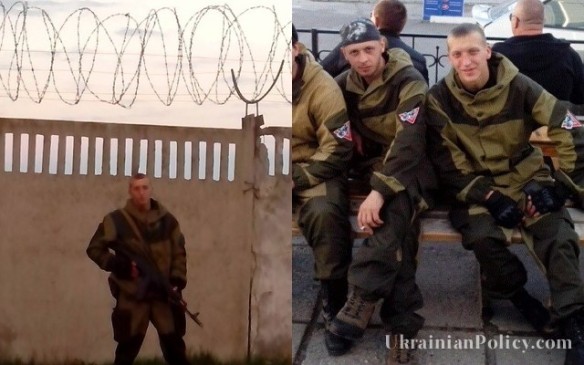
Another fighter from Belorechensk, he is shown above wearing the insignia of the ‘Terek Wolves.’ His website allegedly contained Nazi and ultra-nationalist symbols. If so, they have been removed. It is replete, however, with militaristic, sexist, racist, and homophobic postings. One image celebrates Stalin as ruthless manager:
The caption reads: The Russian team needs a trainer like Stalin: ‘If you don’t win gold, we’ll send you to dig for it!’
The quotation from Vladimir Zhirinovsky reads: ‘Don’t force children to learn English. Let them learn how to use a Kalshnikov machine gun. Then the whole world will start speaking Russian.’
The caption reads: ‘An insult to a person’s external appearance is the deepest, because no one chooses how they are born.’ The crowd of children doing the insulting are of Asian appearance, while the insulted boy is Caucasian. [Source of images: Evgeny Kovalyov, http://vk.com/id181914606]
8. Anton Morozov

Morozov is from Irkutsk.In his youth he was a member of the National Bolshevik party, which blended fascist with bolshevik ideas and symbols, and criticized Putin. Morozov then he moved into Dugin’s Eurasian Union. He promotes a ‘healthy style of life’ and is a rodnover (a member of the ‘native believers,’ a neo-pagan sect). Known in his home town for burning the Israeli flag in public, he has spent time in semi-legal paramilitary organizations. Morozov’s website contains some antisemitic imagery.
The above photograph portrays two Hassidic Jews and the caption reads: ‘Two Poles meet by accident: Rabinovich and Martsinkevich.’
9. Edvard Pitersky
Pitersky identifies himself as a resident of Kharkiv and a member of the Oplot fight club. According to one source, he is a member of the ‘Anti-fascist movement of the South-East‘ and the ‘White Legion,’ a neo-Nazi community (http://euromaidanpr.com/2014/04/23/insurgents-identified/).
10. Olga Cherkerdes
The blogger Tolkovatel presents Olga Chekerdes as a rare example of a woman in the masculine world of mercenaries. According to him, she was born in Sevastopol, where she participated in paramilitary organizations. She considers herself a member of the ‘Don Cossacks of Crimea,’ and in recent years has travelled to Belorechensk for training with the ‘Wolves.’ She idealizes General Piotr Krasnov, who agreed to organize and head Cossack units recruited from anti-bolshevik emigres and Red Amy prisoners of war who were of Cossack background. The Nazis required Krasnov to follow their political line and to maintain a Cossack separatist orientation.
11. ‘Krasnyi’-Andrei Krasilnikov
Tolkovatel reports that Russian documents were apparently found on one of the individuals who burned in the Trades Union Building in Odesa belonged to Andrei Krasilnikov (nicknamed ‘Krasnyi’). Born in 1966, he came from Nizhnii Novgorod, where he worked in the militia’s criminal investigation unit.
On 31 August 2004 he was given a conditional sentence of three years imprisonment by the Nizhnii Novgorod court and banned from serving in any law-enforcement agency for two years. His conviction was for beating three workers in the Gorky automobile factory in August 2003. The militia accused them of stealing machine parts from the factory. When they refused to ‘confess’ they were beaten on the legs with steel pipes. They lodged complaints, were again summoned and beaten with steel pipes, and again lodged complaints.
Eventually, on 16 July 2004 the head of the militia detachment was found guilty and sentenced to four-and-a-half years imprisonment and given a three-year ban from serving in law enforcement. The deputy head, the chief inspector of criminal investigations, and Krasilnikov himself, who was the lead criminal investigator in this case, all recveived similar conditional sentences and bans.
Tolkachov describes these individuals as déclassé element who became mercenaries to make money and demonstrate their worth. They serve the Russian military, which finances, arms, and directs them.
A number of researchers have confirmed the allegiance of these individuals to far-right ideologies, including neo-Nazism. Some, like Tolkachov, feel that such views doom their uprising to failure. The blogger writes: ‘The tormented, impoverished, strongly proletarianized society of Donbas will never accept a right-wing ideology. It is clear that these people [the mercenaries] will not be able to entice the masses.’ This may in the long term prove correct. However, it should be noted that the deep-seated resentment of this population continues to search for political expression. The Party of Regions is now discredited. So is the communist party, in both its Ukrainian and Russian versions. For many decades it has represented ‘a parody of a social movement,’ to use Tolkachov’s words. The blogger concludes that at this moment of crisis the people of the Donbas are being encouraged to fight a mythical ‘fascist’ government in Kyiv while being led by ‘pro-Russian’ military leaders who hold extreme nationalist, and in many cases neo-Nazi views.
It is clear that paramilitary, pro-fascist groups are being used by the Putin administration to destabilize Eastern Ukraine. Moreover, the organized Russian fascist movement is intervening directly into Donetsk. Aleksandr Barkashov, who in 1990 founded the political party and paramilitary organization called Russian National Unity, has been recorded as instructing a pro-Russian leader in Donetsk to forge the results of the ‘referendum’ of 11 May.

On 7 May 2014 the Ukrainian Ministry of Defence intercepted a phone conversation between Barkashov in Moscow and Dmytro Boitsov, the leader of the unregistered organization ‘Orthodox Donbas,’ in Donetsk. In the conversation Boitsov says that his people are calling off the referendum because they feel it cannot be conducted successfully. Barkashov tells him that he should forget about voting for ‘federalization’ and proceed with a vote for the ‘Donetsk People’s Republic.’ He should stop worrying about counting useless ‘papers’ and should simply fill in the voting slips to produce whatever result he considers appropriate. Barkashov suggests either 89% or 99% in favour. The audio recording is available with subtitles in English at: http://euromaidanpr.com/2014/05/07/russia-orchestrating-donetsk-referendum.
In one of his interviews Barashov has stated: ‘I am not a fascist, I am a Nazi’ (Laqueur 189). During the constitutional crisis of 1993, he led his organization’s fighters against Boris Yeltsin’s forces in an attempted defence of the Russian White House. Charged with organizing and inciting mass disorder and illegally bearing arms, he was imprisoned, but early in 1994 the Russian parliament granted him amnesty. In February 1999, an opinion poll ranked him among Russia’s ten most recognizable politicians.
The historian Laqueur says that Barashov was born in 1953 and that his grandfather was one of the ‘purgers’ in the terror of the 1930s. An electrician by training, he has no higher education. He served in the army as a karate instructor. Many members of his organization work as security officers and armed guards.
Barashov believes that a giant conspiracy (‘total genocide’) against the Russian people aims to destroy its ‘racial core’ (‘genotype’). Laqueur writes: ‘Hence the demand to introduce eugenic principles into the future Russian state and the virtual ban on mixed marriages. There will be two classes of citizens, Russians and non-Russians, with the latter being mere inhabitants and not sharing citizens’ rights. The propagation of democratic, humanist, and internationalist values will be a crime’ (Laqueur 189-90).
It remains to be seen how this ideology will play out in the Donbas.
Myroslav Shkandrij
Sources:
Tolkovatel blog. ‘Russian Soldiers of Fortune in the Donbas.’ 5 May 2014 <http://ttolk.ru/?p=20508
>
Lynch, Lily. ‘A Russian Neo-Nazi and Suspected Spree Killer in Serbia.’ Balkanist. 27 August 2013 <http://balkanist.net/right-world/2>
‘Insurgents Identified: The Green Men of VKontakte.’ Inforesist. 23 April 2014 <http://inforesist.org/znakomtes-blizhe-opoznany-vse-chleny-diversionnoj-gruppy-na-donbasse/>
Babiak, Mat. ‘Insurgents identified.’ Ukrainian Policy <http://ukrainianpolicy.com/insurgents-identified-the-green-men-of-vkontakte/>
‘Russia Orchestrating Donetsk Referendum.’ Euromaidanpr <http://euromaidanpr.com/2014/05/07/russia-orchestrating-donetsk-referendum>
Laqueur, Walter. Fascism: Past, Present, Future. New York: Oxford University Press, 1996.
Igor Strelok profile. Crime.in.UA < http://crime.in.ua/statti/20140429/strelkov-portret>
Oleh Kashin interview <http://sputnikipogrom.com/russia/11673/they-say-its-pretty-beautiful-in-magadan>
Strelkov-Girin interview <http://www.kp.ru/daily/26225.7/3107725/>
Berkut-Kobr dossier <http://www.garmata.org/index.php/diversanti/separasti/110-berkut-kobr-terorist-chast-2>









